Podcast: Play in new window | Download (Duration: 14:30 — 16.6MB)
Sign up for our mailing list! We also have t-shirts and mugs with our logo!
This week let’s look at some animals that have evolved rapidly to adapt to human-caused environmental pressures. Thanks to Otto and Pranav for their suggestions!
Further reading:
A light-colored peppered moth (left) and darker-colored peppered moths (right):
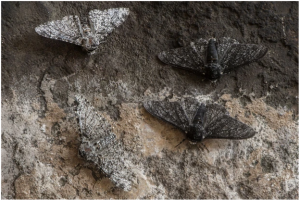
Soot is hard to clean off buildings and other items (image from this page):

A white-crowned sparrow in the California countryside:
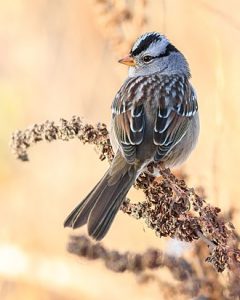
A (deceased museum specimen being photographed) white-crowned sparrow from the city of San Francisco, CA (taken from the study linked above):
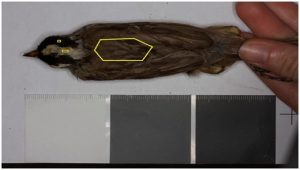
A decorator crab that has attached bits of plastic and other trash to its body (image from this page):
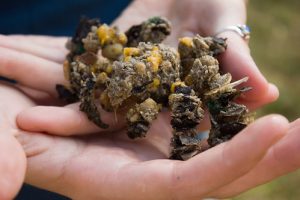
The hermit crab sometimes uses trash instead of shells to hide in:
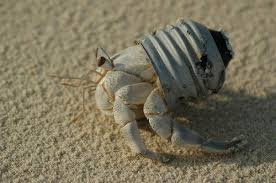
Show transcript:
Welcome to Strange Animals Podcast. I’m your host, Kate Shaw.
This week we have two listener suggestions. Otto suggested we learn about camouflage that mimics modern things, and Pranav suggested animals that show rapid evolution due to humans.
We’ve talked about animals that use camouflage in lots of episodes, especially episode 191, Masters of Disguise. If you want to learn more about camouflage itself, that’s a good one to listen to. In addition, rapid evolution due to humans is a hot area of research right now. It even has its own scientific term, human-induced rapid evolutionary change, often shortened to the acronym HIREC.
Let’s start this episode with the story of a humble moth, because it’s a classic example of both HIREC and modern camouflage.
The peppered moth lives throughout much of the northern hemisphere. Its wingspan is a little over 2 inches across, or about 6 centimeters, and its caterpillar looks just like a little twig. Not only that, the caterpillar can change its coloring to match the twigs of the tree it’s on. But it’s not the caterpillars we’re talking about today.
The peppered moth gets its name from the coloring of its wings, which are white with black speckles, like pepper spilled on a plate. The pattern of speckles is unique to each individual, with some moths having more pepper speckles than others. Some moths have so many speckles that they look gray. But in the 19th century, geneticists studying moths in England noticed that the peppered moth seemed to be changing color as a species. Specifically, some of the peppered moths were completely black.
Black peppered moths had never been documented before 1811. They were still rare in the mid-19th century, but by 1900 almost all of the peppered moths in cities in England were black. Scientists noticed this and tried to figure out what was going on.
Pollution is what was going on. The industrial revolution was in full swing, but all those factories and trains and even ordinary houses were burning coal. Burning coal results in soot that’s carried on smoke and settles on everything. If you have a coal fire in your house, your walls and furniture are going to end up dark with soot. My aunt and uncle renovated a house from the late 19th century and had a lot of trouble cleaning soot from the walls and woodwork, even the old curtains that had been in the house. Similarly, when I lived briefly near Pittsburgh, Pennsylvania, there were still a lot of brick and stone buildings that were black from soot, but one beautiful old church had recently been cleaned and it turned out that the stone it was built from was pale gray, not black.
It wasn’t coal soot getting on the moths, though. It was coal soot on the trees where the moths spent most of their time. Most tree trunks are gray, but with all that coal soot in the air, the trees were coated with it and were much darker gray or even black. A light-colored moth that settled on a black tree branch showed up to predators, but a black moth on the same branch was camouflaged. The black moths survived more often to lay eggs while the white or gray moths didn’t, passing on the genetic likelihood that their babies would grow up to be dark-colored instead of light-colored.
It wasn’t just peppered moths that this happened to, either. More than 100 species of moth were documented to be dark gray or black during this time when they were ordinarily much lighter in color. Scientists call this industrial melanism.
Soot is made up of tiny particles that work their way into the crevices of wood and stone and everything else they come in contact with. You can’t just wipe or rinse it off. It’s acidic too and will kill plants, especially lichens that grow on trees, and it even eats away at stone and brick. It’s dangerous to breathe because the tiny particles lodge in your lungs and eventually stop you from being able to absorb oxygen as efficiently. If you’ve heard of the infamous London smog from the olden days, a big contributor to the smog was coal smoke. In 1952 a five-day smog event in London killed an estimated 12,000 people. That led directly to the Clean Air Act of 1956, and these days London doesn’t have that kind of deadly smog anymore.
Once factories and homes switched to electricity, natural gas, or other alternatives to burning coal, and trains switched to diesel fuel, trees stopped being coated with soot. Older trees that had survived were still dark, but young ones grew up with normal colored trunks and branches. Gradually, the black moths became less and less numerous compared to light-colored moths.
Cities in general result in rapid evolution of animals, including how they camouflage themselves. A study published in May of 2021 found that some birds living in cities are developing different colored feathers. Specifically, white-crowned sparrows living in San Francisco, California have much duller, darker feathers on their backs than white-crowned sparrows living outside of the city. Other studies have found that birds in cities sing much louder and at a higher pitch than birds in the countryside, since they have to compete with traffic and other noise.
A Swiss study on the effects of light on ermine moths indicated that while moths who developed from caterpillars collected from the countryside showed a normal attraction to light, moths from caterpillars collected in the city ignored the light. Since moths often die when they collide with electric lights, the city moths who survived to lay eggs were the ones who didn’t fly into a hot lightbulb.
Another study compared the genomes of white-footed mice that live in various parks in New York City with white-footed mice that live in state parks well outside of the city. The mice in city parks showed a lot less genetic diversity, naturally, since those mice are isolated populations. Mice can’t take cabs to visit mice in other parks, much less leave the city for a vacation. But the city mice showed another surprising difference. Their digestive systems have adapted to a much different diet than their country cousins. Some researchers suggest that the city mice may eat more junk food, which people throw away and the mice find, while other researchers think it’s just a difference in the kinds of insects and plants available in city parks for the mice to eat. Either way, it’s a distinct genetic difference that shows how the city mice are evolving to adapt to their urban environments.
Another example is a type of reptile called the crested anole. It’s related to the iguana and is native to the Americas. There are lots of species and subspecies of anole, many of which live on islands and show distinct adaptations to various habitats. The crested anole lives in Puerto Rico and on some nearby islands and grows up to 3 inches long, or 7.5 cm, not counting its long tail. The male is more brightly colored than the female, usually green or brown with darker spots. It’s not related to the chameleon but it is able to change color. It eats small animals, including insects, worms, even other anoles. Anoles are really interesting animals that deserve their own episode one day, so let’s just talk about how the crested anole that lives in cities has adapted to urban life.
One thing the crested anole is known for is its ability to climb right up tree trunks and even perch head-down in a tree. Its toe pads have microscopic scales and hairs that help them adhere to smooth surfaces, something like a gecko’s toes. But there’s a big difference in a tree trunk, no matter how smooth it is, and a pane of glass. Anoles in cities can climb up and down windows and painted walls. Researchers examined the toe pads of city crested anoles and compared them to the toe pads of crested anoles who lived in the countryside. They found that the city anoles had larger toes with more scales, and they even had longer legs. The research team also raced anoles along various surfaces and filmed them in slow motion to study how they were able to maneuver, which sounds like a great day at work.
The crested anoles have only lived in cities for a few decades, so their differences from country anoles evolved very quickly. But not all species of anole can adapt as well and as rapidly as the crested anoles have. Other city anole species don’t show differences from their country cousins.
Human-induced rapid evolutionary change isn’t restricted to cities. Trophy hunters who target the biggest animals with the biggest horns or antlers and leave smaller individuals alone have resulted in only smaller males with smaller horns or antlers surviving to breed. Many populations of bighorn sheep now actually only have small horns. Similarly, elephants have been killed for their tusks for long enough that many elephants are being born without tusks, because tuskless elephants are the ones that survive to breed. Entire populations of some fish species are smaller overall after many generations of being caught with nets, because only the individuals who are small enough to escape the nets survive to breed.
I tried hard to find more examples of animals that camouflage themselves to blend in to human-made items like roads. I’m sure this is happening throughout much of the world, but I couldn’t find any scientific studies about it. If any of you are thinking of going into biology, that might be an interesting field of study. But I did find one other example.
Self-decoration is a type of camouflage I don’t think we’ve talked about before. It’s where an animal decorates its body with items that help it blend in with its surroundings. Some caterpillars will stick little bits of lichen or other plant pieces to their bodies to help them hide, and some invertebrates of various kinds actually pile their own poop on their back as a disguise.
A group of crabs called decorator crabs will stick plants, sponges, and other items to their backs, and different species have preferences as to what items they use. Some species prefer stinging or toxic decorations, such as certain sea anemones which they basically pick up and plant on their backs. Researchers think the sea anemones actually benefit from being used as camouflage, because crabs are messy eaters and the anemones can catch and eat pieces of food that float away from the crab’s mouthparts. A decorator crab’s carapace is often rough in texture with tiny hooks to help things stick to it like Velcro.
Some decorator crabs don’t seek out particular decorations but just make use of whatever small items they find in their local environment. In the past few decades, scientists, divers, and other people who find crabs interesting have noticed more and more decorator crabs using little pieces of trash as decoration. This includes fragments of plastic and pieces of fishing nets.
This is similar to what’s happening with hermit crabs, which we talked about in episode 182. In many places hermit crabs are using trash like bottle caps instead of shells since there’s so much trash on beaches these days. This is your reminder to pick up any trash you find on the beach, but be careful not to cut yourself and also make sure you’re picking up actual trash and not a camouflaged crab.
You can find Strange Animals Podcast at strangeanimalspodcast.blubrry.net. That’s blueberry without any E’s. If you have questions, comments, or suggestions for future episodes, email us at strangeanimalspodcast@gmail.com. If you like the podcast and want to help us out, leave us a rating and review on Apple Podcasts or Podchaser, or just tell a friend. We also have a Patreon at patreon.com/strangeanimalspodcast if you’d like to support us for as little as one dollar a month and get monthly bonus episodes.
Thanks for listening!